CGKB News and events Procedures
Please click on the boxes in the diagram below or use the menu on the left to go to the topic of your interest.

Conservation
.jpg) View chapter on conservation methods by clicking on the icon above. (0.1 MB) |
Page compiled by: Bioversity International/ILRI, Addis Ababa, Ethiopia (Alexandra Jorge); ILRI, Addis Ababa, Ethiopia (Jean Hanson) including information extracted from: Engels JMM, Visser L, editors. 2003. A guide to effective management of germplasm collections. IPGRI Handbooks for Genebanks No. 6. IPGRI, Rome, Italy.
Conservation of plant germplasm can be done on site (in situ) and off site (ex situ).
In situ conservation
This type of conservation refers to the conservation of germplasm in ecosystems and natural habitats and the maintenance and recovery of viable populations of species in their natural surroundings. In the case of domesticated or cultivated species, it refers to their conservation in the surroundings where they have developed their distinctive properties. This is generally done in protected areas mostly for the conservation of wild relatives, and on-farm or in home gardens for the conservation of cultivated species. This type of conservation is not described further the Crop Genebank Knowledge Base.
Ex situ conservation
This type of conservation is the storage of seeds or plant material under artificial conditions (other than their natural environment), to efficiently and effectively guarantee its longevity viability and availability. It is the type of conservation mostly used in genebanks. It covers a range of methods suitable for various types of seeds or plant materials. It ranges from cold storage of seeds or propagules, in vitro (tissue culture or cryopreservation), field, pollen or DNA conservation.
With ex situ conserveration two types of storage are recognized: storage of samples for long-term security – referred to as base collections – and storage of samples for immediate use – referred to as active collections. The storage conditions and distribution arrangements of these stores vary.
Base collections
A base collection is a set of accessions in which each is distinct and as close as possible to the original sample in terms of genetic integrity. Normally, material is not distributed from base collections directly to users. Base collections are only used to regenerate active collections (FAO, 2013). In seed banks, samples in base collections are stored for long periods at below 0°C – usually at -18° to -20°C – to maintain seed viability and, in cryobanks, specially prepared in vitro culture samples are stored for long periods at -196°C, usually in liquid nitrogen.
Engels and Visser (2003) introduced the term ‘most-original sample’ (MOS) to qualify the samples in base collections. A MOS consists of genetic material that has undergone the lowest number of regenerations since the material was acquired by the genebank; it may be a sub-sample of the original seed lot or a seed sample from the first regeneration cycle if the original seed lot required regeneration before storage or a cryopreserved sub sample of the first in vitro culture cycle.
Active collections
Active collections consist of accessions that are immediately available for distribution. These accessions are accessed frequently and storage of active collections can be in seed banks, vegetative banks, field banks and in vitro banks. Seeds are maintained in conditions that ensure at least 65% viability for 10-20 years (FAO, 2013) and in vitro cultures are maintained in slow growth conditions. Samples in vegetative banks are only stored for a few months but perennial living plants in field banks can be maintained for 20 years or more.
|
|
References and further reading
Engelmann F, Engels JMM. 2001. Technologies and strategies for ex situ conservation. In: Engels JMM, Ramanatha Rao V, Brown AHD, Jackson MT, editors. Managing plant genetic diversity. CABI, UK. 512p.
Engels JMM, Ramanatha Rao V, Brown AHD, Jackson MT, editors. 2001. Managing plant genetic diversity. CABI, UK. 512p.
Engels JMM, Visser L, editors. 2003. A guide to effective management of germplasm collections. IPGRI Handbooks for Genebanks No. 6. IPGRI, Rome, Italy. Available in English (1.4 MB) and Spanish (1.5 MB).
FAO. 2013. Genebank standards for plant genetic resources for food and agriculture. Food and Agriculture Organization of the United Nations, Rome. Available in English, Spanish, French, Arabic, Russian and Chinese here.
Rao NK, Hanson J, Dulloo ME, Ghosh K, Nowel D, Larinde M. 2006. Manual of seed handling in genebanks. Handbooks for Genebanks No. 8. Bioversity International, Rome, Italy. Available in English (1.5 MB), Spanish (1.4 MB) and French (1.9 MB).
Watch a great documentary on the importance of genetic diversity, landraces and crop wild relatives, to the future of agriculture in the face of climate change and other challenges:
http://www.seedhunter.com/watch.html#assets/images/gallery/crew-sally-ingleton-phillip-bull-svalbard.jpg
Vegetative bank
Contributors to this section: ILRI, Ethiopia (Jean Hanson); Bioversity International/ILRI, Ethiopia (Alexandra Jorge).
Storing plant propagules using cold storage
Vegetative propagules of several tuber crops, including potato, sweet potato, yam and cassava can be conserved under cold conditions of 4-20°C for several months between one harvest and the next planting season. Cold storage avoids deterioration following the harvesting of fresh tubers or stem cuttings and consequent losses caused by both physiological changes within the plant by reducing respiration and infection by pathogens and pests during storage.
Pretreatment
Storage propagules should be free of damage caused by insects and nematodes and any other visible symptoms of diseases before storage. Any type of wounds, scraping and peeling can affect the storage life of vegetative material by allowing fungi and bacteria to enter the plant and causing rotting. The storage propagules should be disinfected as soon as possible after harvest using either a 5% sodium hypochlorite solution or an insecticide and fungicide solution and soaking the propagules inside mesh sacks or storage containers for 10 minutes.
|
|
Storage
The propagules selected for storage are usually stored in mesh sacks, or open boxes made of wood, or plastic to allow air circulation with duplicated labels with the identification number, both inside and outside the container. Stems are often more robust and can be stored in bundles or in polythene bags with the cut ends covered with wax to prevent excessive drying during storage. The material should be monitored weekly for signs of rotting, insect damage or rodent damage.
Reported methods for storage include:
Sweet potato storage tubers may be cured by placing them in a high temperature chamber (25-30ºC) with a high relative humidity (RH) (85-90%) for 4-7 days in order to heal all wounds and then stored under a controlled temperature of 12ºC and a high relative humidity for up to 7 months.
Potato tubers are usually stored at temperatures from 2 to 14 ºC and a relative humidity around 70% in the dark for up to 6 months.
Cassava stems with viable buds can be stored at 20–23ºC and 70–80% RH in bundles or in polythene bags in drier areas during the dry season.
Yam storage tubers should be allowed to dry in the shade for 4 to 6 weeks and can then stored at 18–20°C in a dry cool area for 3 to 4 months. Chilling damage occurs when tubers are stored below 10°C.
References and further reading
Dumet D, Adeyemi A, Ojuederie O. Cassava in vitro processing and gene banking. IITA, Nigeria. Available from: http://www.iita.org/cms/articlefiles/515-genebank_Cassava_manual.pdf. Date accessed: 24 March 2010.
FAO. 2013. Genebank standards for plant genetic resources for food and agriculture. Food and Agriculture Organization of the United Nations, Rome. Available in English, Spanish, French, Arabic, Russian and Chinese here.
Kushman LJ, Wright FS. 1969. Sweetpotato storage. Agricultural Handbook N° 358. USDA, Washington, D.C.
Huamán Z. Clonal Sweetpotato germplasm management training manual. Section 2.1 Maintenance of sweetpotato germplasm in field genebanks. CIP, Peru. Available from: http://www.cipotato.org/csd/materials/Sweetpotato/Batsect2.1.pdf. Date accessed: 24 March 2010.
Seed bank
.jpg) View chapter on seed storage by clicking on the icon above. (0.1 MB) |
Page compiled by: Bioversity International/ILRI, Addis Ababa, Ethiopia (Alexandra Jorge); ILRI, Addis Ababa, Ethiopia (Jean Hanson) including information extracted from: Rao NK, Hanson J, Dulloo ME, Ghosh K, Nowel D and Larinde M. 2006. Manual of seed handling in genebanks. Handbooks for Genebanks No. 8. Bioversity International, Rome, Italy. 147pp.
Storing seeds using cold storage
Storing genetic diversity as seed is the best researched, most widely used and most convenient method of ex situ conservation. Much is known about the optimum treatment of the seeds of most major crops. Requirements include adequate drying (seed moisture contents as low as 3% for oily seeds and 5% or more for starchy seeds); appropriate storage temperature (-18°C is recommended for long-term storage); and careful production of quality seed to ensure the greatest longevity (storing them in hermetically-sealed containers).
|
Packing seeds for cold storage at the USDA genebank (photo: L. Guarino, by kind permission of USDA genebank in Ames, Iowa, USA) |
|
A cold storage room (photo: ILRI) |
Orthodox seeds
It is the principal conservation method for species producing orthodox seeds that withstand desiccation to low moisture content and storage at very low temperatures. Most arable and forage species, and many tree species, produce seeds in this category.
Recalcitrant seeds
Several important tropical and sub-tropical tree species produce seeds that do not survive desiccation and cannot tolerate low temperatures, and which are therefore not easy to store; these are known as recalcitrant seeds. Techniques exist for storing some recalcitrant seeds, but the seeds are usually short-lived and each species requires its own method.
Intermediate seeds
A third category of seeds showing intermediate behaviour has also been recognized: these seeds tolerate combinations of desiccation and low temperatures. There is, in fact, a gradient from orthodox to recalcitrant, with no sharp boundaries between categories. Although research has been conducted to overcome problems associated with seed conservation, little progress has been made beyond short-term storage of non-orthodox seeds.
Principles of seed storage
The underlying principle of successful seed storage is to maintain genetic integrity of accessions as seeds with high viability for long periods. Seeds of the original sample should be stored under the best possible conditions to ensure safe long-term survival, while seeds of accessions that are frequently requested by breeders or other users should be stored in the active collection. Genebanks may maintain both base and active collections or focus on only one. Such decisions are based on the purpose and needs of the genebank and economics of conservation.
For orthodox seeds, low temperatures and low moisture content are used to extend longevity and reduce regeneration intervals with related risks to loss of diversity and genetic integrity. Genebank requirements differ for crops and it is important to select a combination of temperature and seed moisture content specific for the species that will retain high viability for many years of conservation (see specific crop regeneration guidelines).
Practical considerations
Location
Choice of location of the seed store is important to maximize efficiency and minimize cost:
- Select a site with a cool, dry environment, if possible, to improve the efficiency of controlling the environment.
- Select a secure site with the best possible physical safety against theft, and avoid areas with natural threats such as earthquakes, volcanoes and hurricanes.
- Select a site with reliable electricity supply and adequate rainfall or water supply needed for associated laboratories.
- Construct the building with shade and North facing to minimize solar heating. In areas with erratic electricity supply, a standby generator is essential to maintain the controlled environment.
Type of store
The commonly available options for seed storage are walk-in cold stores, freezers and liquid nitrogen dewars. The choice depends on the number of accessions to be stored, seed size and storage temperatures selected.
- Select walk-in stores for large collections or large seeded species where space is needed.
- Select chest or upright freezers when collections are small and sub-zero temperatures are required.
- Select liquid nitrogen storage when collections are small and sub-zero temperatures are required for very long-tern storage.
- Assess the current collection size and probable number of accessions expected over the next ten years to determine the size and type of store needed.
- Use good insulation of about 200 mm thickness on coldrooms to reduce the electrical running costs.
- Monitor and log the temperature daily and check levels of liquid nitrogen weekly. An alarm system can be used to alert staff to malfunction of the cooling system and need to top-up liquid nitrogen.
Sample size
- The required minimum number of seeds for a genetically homogenous sample is 3000-4000 seeds and for a genetically heterogeneous sample it is 4000-12 000 seeds.
- More seeds should be stored for those accessions that are frequently requested or have long regeneration periods (some slow growing trees), to reduce regeneration requirements.
Organization of space
The organization of storage space depends on the type of storage facility and the type of containers used in the genebank. In view of the cost of maintaining cold storage, the space should be optimized so that a maximum number of seed accessions can be stored.
- For a walk-in cold store, use moveable racks that maximize storage space.
- Arrange the distance between each shelf according to the size of containers, leaving a gap of about 10 cm above the containers to allow cold air circulation.
- Arrange small containers or aluminium foil bags in boxes or trays to keep them together and save space on the shelves.
- Use a coding system based on the location for sample entry and retrieval.
Safety duplication
- Duplicate seed genebanks in more than one location as a safety backup. Accessions available at other genebanks may require fewer duplicates than unique samples.
- Select a site for safety duplication to minimize possible risks and provide the best possible storage facilities.
- A third safety backup can be kept in the Svalbard Global Seed Vault for added security.
For more information about safety duplication see the safety duplication page.
References and further reading
Cromarty AS, Ellis RH, Roberts EH. 1982. Handbooks for Genebanks No. 1: The Design of Seed Storage Facilities for Genetic Conservation. IPGRI, Rome, Italy. Available in English. 100p.
Ellis RH. 1998. Longevity of seeds stored hermitically at low moisture contents. Seed Science Research 8 (Suppl. 1): 9-10.
Engels JMM, Visser L, editors. 2003. A guide to effective management of germplasm collections. IPGRI Handbooks for Genebanks No. 6. IPGRI, Rome, Italy. Available in English (1.4 MB) and Spanish (1.5 MB).
FAO. 2013. Genebank standards for plant genetic resources for food and agriculture. Food and Agriculture Organization of the United Nations, Rome. Available in English, Spanish, French, Arabic, Russian and Chinese here.
Hong TD, Ellis RH. 1996. A protocol to determine seed storage behaviour. IPGRI Technical bulletin No.1. IPGRI, Rome.
Hong TD, Linington SH, Ellis RH. 1996. Seed storage behaviour: A compendium. Handbooks for Genebanks No. 4. IPGRI, Rome.
Smith RD, Dickie JB, Linington SH, Pritchard HW, Probert JR. (eds.). 2003. Seed conservation: Turning science into practice. Royal Botanic Gardens, Kew.
Rao NK, Hanson J, Dulloo ME, Ghosh K, Nowel D, Larinde M. 2006. Manual of seed handling in genebanks. Handbooks for Genebanks No. 8. Bioversity International, Rome, Italy. Available in English (1.5 MB), Spanish (1.4 MB) and French (1.9 MB).
In vitro bank
.jpg) View the guidelines on in vitro and field collection management by clicking on the icon above. (0.5 MB) |
Page compiled by: Bioversity International/ILRI, Addis Ababa, Ethiopia (Alexandra Jorge); ILRI, Addis Ababa, Ethiopia (Jean Hanson) including information extracted from: Reed BM, Engelmann F, Dulloo ME, Engels JMM. 2004. Technical guidelines for the management of field and in vitro germplasm collections. IPGRI Handbook for Genebanks No.7. IPGRI, Rome, Italy.
Tissue culture conservation
|
|
Seed storage is the preferred conservation method. However, it is not feasible for germplasm from clonal crops which are either vegetatively propagated and/or do not produce seeds, or for species with short lived recalcitrant seeds. For some genotypes, elite genetic combinations are only preserved through clonal means. Their conservation is dictated by breeding strategy as heterozygosity does not permit the maintenance of desired characteristics. Clonally propagated plants incur special needs for their conservation. Common options for storage include maintenance in field genebanks, and for species producing dormant vegetative propagules, conservation in cold stores (Reed, 2001) called vegetative banks. These approaches have limitations regarding efficiency, costs, security and long-term maintenance. In vitro conservation, which involves maintenance of explants in a sterile, pathogen-free environment is therefore preferentially applied to clonal crop germplasm and multiplication of species that produce recalcitrant seeds, or do not produce seeds. It also supports safe germplasm transfers under regulated phytosanitary control. This modern technique has already been applied for multiplication, storage and collection of germplasm of more than 1000 species.
|
|
Conservation in tissue culture in in vitro genebanks is often combined with cryopreservation. Cultures in the active genebank are maintained by successive subculturing allowing culture renewal and distribution. For medium term storage, sub-culture intervals are extended, reducing processing costs by arresting growth using cold treatments, adapted light conditions, culture medium modifications (osmotic active compounds, growth retardants). This increases efficient use of resources and staff time and offsets selection risks and contamination
|
|
Advantages
One of the major advantages of in vitro conservation of genetic resources is that tissue culture collections can be cleaned to provide a source of disease-free material. In vitro cultures are free of fungi and most bacteria while viruses can still be present. Therefore careful virus indexing procedures need to be applied to ensure material is disease free. Tissue culture storage also allows the conservation of germplasm in a protected environment, aseptic plant production, safe and easy international exchange of plant material and lower conservation costs. It is most appropriate for rapid multiplication purposes, dissemination and active collections.
Disadvantages
Maintaining material as shoot tip or meristem cultures, even when applying reduced growth conditions, remains labour intensive. It also involves the risk of losing valuable germplasm through accidental contamination of cultures and human error. Another major impediment of tissue culture storage under slow growth conditions is the possibility of genetic instability due to somaclonal variation (mutations that occur spontaneously in vivo or in vitro, whose frequency is generally increased during in vitro culture).
Practical considerations
Security
Security measures should be compliant with safety and ethical authorities regulations and guidelines, including observance of: (a) the Convention on Biological Diversity, (b) the Material Transfer Agreement, with respect to genetic resources exchange and (c) the International Plant Protection Convention. Security should ensure:
- Purity: freedom from contaminating organisms.
- Authenticity: correct identity.
- Stability: fit-for-purpose and trueness-to-type.
Good laboratory practices, application of aseptic techniques with careful containment strategies, clear and accurate documentation and avoiding practices that increase risks of genetic variation are all essential to ensure security of cultures.
Culture facilities
|
|
Research may be necessary to determine the appropriate environment to successfully culture and grow materials of different species in in vitro cultures. Some general guidelines are:
- Use culture growth rooms with temperature control, lighting and shelving.
- Aim for a room where the humidity is 40–50%. High humidity increases fungal growth, while low humidity dries cultures and creates dust problems.
- Use an isolated growth room for in vitro explants of materials taken directly from the field to allow time to detect insect infestations and prevent their spread to other cultures.
- Ensure a light intensity in the range from 10 to 1000 μmol S-1 m-2. Most plant cultures require 50–200 μmol S-1 m-2.
- Use ventilation systems or air-conditioning units to regulate temperature. Air should not flow directly onto the cultures. Common growth room temperatures range from 22ºC to 28ºC, depending on species requirements.
- Back-up generators are advisable for areas with frequent power cuts to control temperature and light.
Genetic stability during storage
Somaclonal variation, while a problem with plants regenerated from single cells, callus or adventitious buds, is not common in plants micropropagated from axillary buds. The frequency of somaclonal variation occurring, gross chromosomal aberrations and in vitro selection are enhanced in prolonged tissue culture. Exposure to minimal growth conditions over long periods of time can also be expected to lead to genetic change. It is significant that asexually propagated species for germplasm conservation may display a higher frequency of somaclonal variation as compared to those where the propagule is a seed. Great care should be taken to select culture practices to reduce this variation and ensure genetic integrity.
Preferred practices are:
- Avoid using germplasm propagated via dedifferentiated and adventitious routes for conservation.
-
Select germplasm from young cultures because somaclonal variation increases and totipotency decreases during prolonged culture.
Medium term storage using slow growth
The objective of slow growth (or minimal growth) is to reduce the sub-culture interval to a critical level which does not impose a long-term deleterious effect on the germplasm, or the stability of regenerated/regrown plants. However, slow growth treatments incur some level of stress and it is essential to optimise regimes for each species for timing of sub-culture and regeneration. Minimal growth storage is achieved via several treatments, applied singularly or in combination:
-
Physical growth limitation
- Low temperature
- Low light/restricted photoperiod
- Minimal containment
- Minimal O2
- Osmotic (water) stress
-
Chemical growth limitation
- Growth regulator retardation
- Growth inhibitors
-
Minimal nutrition
- Low macro nutrient levels
- Low micro nutrients levels
Choice of treatment is largely species-dependent and dictated by the ability of specific cultures to withstand the stresses incurred.
Culture and storage protocols have been developed for several important vegetatively propagated crops, including banana, cassava, potato, sweet potato, yam.
Banana - http://cropgenebank.sgrp.cgiar.org/index.php?option=com_content&view=article&id=545&Itemid=740&lang=english
Cassava - http://webapp.ciat.cgiar.org/asia_cassava/pdf/proceedings_workshop_02/136.pdf
Potato - http://www.cipotato.org/csd/Materials/Tissue/Capitulo4.pdf
Sweet potato - http://www.cipotato.org/csd/materials/Sweetpotato%202-4.asp
Yam - http://www.ejbiotechnology.info/content/vol1/issue3/full/2/bip/
References and further reading
Ashmore SW, Engelmann F, editors. 1997. Status report on the development and application of in vitro techniques for the conservation and use of plant genetic resources. International Board for Plant Genetic Resources, Rome (Italy). 67 p.
Batugal PA, Engelmann F, editors. 1998. Coconut embryo in vitro culture. Proceedings of the First Workshop on Embryo Culture, 27-31 October 1997, Banao, Guinobatan, Albay, Philippines. 164 p. Available from: http://www2.bioversityinternational.org/publications/Web_version/363 Date accessed 20 April 2011.
Benson EE, Harding K, Debouck D, Dumet D, Escobar R, Mafla G, Panis B, Panta A, Tay D, Van den houwe I, Roux N. 2011. Refinement and standardization of storage procedures for clonal crops - Global Public Goods Phase 2: Part I. Project landscape and general status of clonal crop in vitro conservation technologies. System-wide Genetic Resources Programme, Rome, Italy. Available here (2.5 MB).
Benson EE, Harding K, Debouck D, Dumet D, Escobar R, Mafla G, Panis B, Panta A, Tay D, Van den houwe I, Roux N. 2011. Refinement and standardization of storage procedures for clonal crops - Global Public Goods Phase 2: Part II. Status of in vitro conservation technologies for: Andean root and tuber crops, cassava, Musa, potato, sweet potato and yam. System-wide Genetic Resources Programme, Rome, Italy. Available as full size PDF (9 MB) and light version (3.5 MB).
Benson EE, Harding K, Debouck D, Dumet D, Escobar R, Mafla G, Panis B, Panta A, Tay D, Van den houwe I, Roux N. 2011. Refinement and standardization of storage procedures for clonal crops - Global Public Goods Phase 2: Part III. Multi-crop guidelines for developing in vitro conservation best practices for clonal crops. System-wide Genetic Resources Programme, Rome, Italy. Available here (4.5 MB).
Chandel KPS, Pandey R, Paroda RS, Arora RK. 1991. Plant genetic resources conservation: recent approaches. Plant genetic resources: conservation and management. Concepts and approaches. International Board for Plant Genetic Resources New Delhi (India. p. 247-272.
Chaudhury R, Pandey R, Malik SK, Bhag Mal, editors. 2003. In vitro conservation and cryopreservation of tropical fruit species. Proceedings of the Regional Training Course on In Vitro Conservation of Tropical Fruit Genetic Resources, organized at the National Bureau of Plant Genetic Resources (NBPGR), New Delhi, India, 4-16 February 2002. New Delhi (India): IPGRI/NBPGR. 293 p.
Debergh PC, Zimmerman RH, editors. 1991. Micropropagation Technology and Application. Kluwer Academic, Dordrecht, The Netherlands.
Engelmann F, Batugal P, Oliver J, editors. 2002. Coconut embryo In vitro culture: Part II. 2nd International Coconut In vitro Culture Workshop, Merida, Mexico, 14-17 March 2000.
Engels JMM, Visser L, editors. 2003. A guide to effective management of germplasm collections. IPGRI Handbooks for Genebanks No. 6. IPGRI, Rome, Italy. Available in English (1.4 MB) and Spanish (1.5 MB).
FAO. 2013. Genebank standards for plant genetic resources for food and agriculture. Food and Agriculture Organization of the United Nations, Rome. Available in English, Spanish, French, Arabic, Russian and Chinese here.
Frison EA. 1988. IBPGR's (International Board for Plant Genetic Resources) interests and needs for pathogen testing of germplasm. Conservation and movement of vegetatively propagated germplasm: In vitro culture and disease aspects. Report of a subcommittee meeting. International Board for Plant Genetic Resources. Advisory Committee on In Vitro Storage. Rome (Italy. p. 15-16.
Fuentealba A, Contreras M A, Esquinas-Alcazar JT. 1987. Tecnicas de cultivo in vitro para conservacion de germoplasma. Anales. Simposio "Recursos Fitogeneticos" Valdivia (Chile): UACH/IBPGR. p. 174-177.
George EF. 1993. Plant Propagation by Tissue Culture—Part 1. Exegetics Limited, UK.
George EF. 1996. Plant Propagation by Tissue Culture—Part 2. Exegetics Limited, UK.
IBPGR. 1988. Conservation and movement of vegetatively propagated germplasm: In vitro culture and disease aspects. Report of a subcommittee meeting. International Board for Plant Genetic Resources. Advisory Committee on In Vitro Storage Rome (Italy). 63 p.
Iwanaga M. 1994. Cassava genetic resources management at CIAT International network for cassava genetic resources. Report of the first meeting of the International Network for Cassava Genetic Resources held at CIAT, Cali, Colombia, 18-22 August 1992 International Crop Network Series (IPGRI) no. 10. Rome (Italy). p. 77-86.
Kyte LA, Kleyn J. 2001. Plants from Test Tubes. An Introduction to Micropropagation (3rd edn). Timber Press, Portland, Oregon, USA.
Mafla G, Roa JC, Aranzales E, Debouck D. 2009. Handbook of procedures for in vitro germplasm conservation of the genus Manihot. CIAT, Cali, Colombia. 56 pp. Available here (8 MB).
Malaurie B, Pungu O, Dumont R, Trouslot MF. 1993. The creation of an in vitro germplasm collection of yam (Dioscorea spp.) for genetic resources preservation. Euphytica65:113–122.
Mandal BB. 1997. Application of in vitro/cryopreservation techniques in conservation of horticultural crop germplasm. Acta Hort. (ISHS) 447:483-490.
Ng SYC. 1992. Micropropagation of white yam (Dioscorea rotundata Poir.). Pp. 135–159 in Biotechnology in Agriculture and Forestry, Vol. 19, High-Tech and Micropropagation III (Y.P.S. Bajaj, ed.). Springer, Berlin, Germany.
Ng SYC. 1994. Production and distribution of virus-free yam (Dioscorea rotundata Poir.). Acta Horticult. 380:324–328.
Parra Quijano M, Nustez C, Reyes LM. 2005. [Collection and conservation of ulluco (Ullucus tuberosus Caldas) in Colombia]. Colecta y conservacion de ulluco (Ullucus tuberosus Caldas) en Colombia. Plant Genetic Resources Newsletter (IPGRI/FAO) no. 142: 63-67. Available from: http://www2.bioversityinternational.org/publications/pgrnewsletter/article.asp?lang=en&id_article=10&id_issue=142 Date accessed 20 April 2011
Reed BM. 1990. Multiplication of Rubus germplasm in vitro: A screen of 256 accessions. Fruit Varieties J. 44:141–148.
Reed BM. 1991. Application of gas-permeable bags for in vitro cold storage of strawberry germplasm. Plant Cell Reports 10:431-434.
Reed BM. 1992. Cold storage of strawberries in vitro: A comparison of three storage systems. Fruit varieties journal 46:98-102.
Reed BM. 2001. Implementing cryogenic storage of clonally propagated plants. Cryoletters 22:97-104.
Reed BM, Engelmann F, Dulloo ME, Engels JMM. 2004. Technical guidelines for the management of field and in vitro germplasm collections. IPGRI Handbook for Genebanks No.7. IPGRI, Rome, Italy. Available here.
Reed BM, Paynter C, Bartlett B. 2002. Shipping procedures for plant tissue cultures. USDA-ARS-NCGR. Available from: http://www.ars-grin.gov/cor/presentations/shipping2001/sld001.htm. Date acchessed: 24 March 2010.
Reed BM, Chang Y. 1997 Medium and long term storage of in vitro cultures of temperate fruit and nut crops. In
Conservation of Plant Genetic Resources In Vitro (M.K. Razdan, ed.). Oxford and IBH Publishing, India.
Reed BM. Stalker HT, Chapman C. 1989. In vitro conservation of germplasm. Scientific management of germplasm: characterization, evaluation and enhancement. IBPGR Training Courses: Lecture Series (IBPGR) no. 2. Rome (Italy. p. 23-30.
Reed BM, Tanprasert P. 1995. Detection and control of bacterial contaminants of plant tissue cultures. A review of recent literature. Plant Tissue Cult. Biotechnol. 1:137–142.
Thorpe TA, editor. 1981. Plant Tissue Culture Methods and Applications in Agriculture (1st edn). Academic Press, New York, USA.
Van den Houwe I, De Smet K, Tezenas du Montcel H, Swennen R. 1995. Variability in storage potential of banana shoot cultures under medium term storage conditions. Plant Cell, Tissue Organ Cult. 42:269–274.
Withers LA. 1988. The current status of in vitro culture for the international movement of plant germplasm. Conservation and movement of vegetatively propagated germplasm: In vitro culture and disease aspects. Report of a subcommittee meeting. International Board for Plant Genetic Resources. Advisory Committee on In Vitro Storage. p. 47-60.
Withers LA, Paroda RS, Arora RK. 1991. Biotechnology and plant genetic resources conservation. Plant genetic resources: conservation and management. Concepts and approaches. International Board for Plant Genetic Resources, New Delhi (India). p. 273-297.
More Articles...
Subcategories
-
main
- Article Count:
- 1
-
Collecting
- Article Count:
- 31
-
Acquisition/Registration
- Article Count:
- 2
-
Sample processing
- Article Count:
- 1
-
Quality testing
What is quality testing?
The quality testing of seeds or plant materials assures that the materials to be conserved are in good conditions, i.e. can be grown again (viable) and are free of external contaminants (pests and diseases) and external genes (artificially produced genes). They are composed by three major aspects:
- Viability testing
- Plant health
- TransgenesThe quality of seed can be tested with a germination test
- Article Count:
- 5
-
Methods of conservation
- Article Count:
- 2
-
Cold storage
- Article Count:
- 1
-
Tissue culture
- Article Count:
- 1
-
Cryopreservation
- Article Count:
- 1
-
Molecular
- Article Count:
- 1
-
In field conservation
- Article Count:
- 1
-
Characterization
- Article Count:
- 1
-
Regeneration
What is Regeneration?
Regeneration is the renewal of germplasm accessions by sowing seeds or planting vegetative materials and harvesting the seeds or plant materials which will posses the same characteristics as the original population.
Germplasm regeneration is the most critical operation in genebank management, because it involves risks to the genetic integrity of germplasm accessions due to selection pressures, out-crossing, mechanical mixtures and other factors. The risk of genetic integrity loss is usually high when regenerating genetically heterogeneous germplasm accessions. Germplasm regeneration is also very expensive.Regeneration on fields
Why should germplasm be regenerated?
Germplasm is regenerated for the following purposes:
1. To increase the initial seeds or plant materials
In new collections or materials received as donations, the quantity of seeds or plant materials received by the genebank is often insufficient for direct conservation. Seeds or plant materials may also be of poor quality due to low viability or infection. All these materials require regeneration. Newly acquired germplasm of foreign origin may need to be initially regenerated under containment or in an isolation area under the supervision of the national phytosanitary authorities.
2. To replenishing seed stocks or plant materials in active and base collections
Increase seed stocks or plant materials of accessions that have:
- Low viability identified during periodic monitoring;
- Insufficient stocks for distribution or conservation.
Active collections should be regenerated from original seeds or plant materials in a base collection; this is particularly important for out-breeding species. Using seeds from an active collection for up to three regeneration cycles before returning to the original seeds or plant materials (base collection) is also acceptable (FAO/IPGRI 1994).
Base collections should normally be regenerated using the residual seed or plant materials from the same sample.How is it done?
If possible, regenerate germplasm in the ecological region of its origin. Alternatively, seek an environment that does not select some genotypes in preference to others in a population.
If no suitable site is found, seek collaboration with an institute that can provide a suitable site or regenerate in a controlled environment such as a growth room.
Examine the biotic environment in the context of prior information about the plants and past experience - an inappropriate biotic environment can be detrimental to plants, seed or propagation materials quality and the genetic integrity of an accession.Meeting special requirements
There may be special requirements for regeneration of accessions with special traits that breeders and researchers use frequently—such as high-yielding, pest-and disease-resistant accessions and genetic stocks — or if there are insufficient seeds for safety duplication and repatriation.
The following factors when regenerating germplasm accessions must be consider:- Suitability of environment to minimize natural selection;
- Special requirements, if any, to break dormancy and stimulate germination (such as scarification);
- Correct spacing for optimum seed set; and
- Breeding system of the plant and need for controlled pollination or isolation.Regeneration in a protected environment
When should it be done?
It should be done when either the quantity and/or the quality of a particular seed or plant material are not sufficient in a genebank.
The regeneration of accessions that have inadequate quality (low viability) should take priority over that of accessions with inadequate numbers of seeds or planting materials.
The regeneration of accessions in base collections should take priority over regenerating those in active collections.
- Article Count:
- 1
-
Dissemination
- Article Count:
- 1
-
Safety duplication
- Article Count:
- 1
-
Information/Documentation
- Article Count:
- 1
-
List of equipment and supplies
- Article Count:
- 1





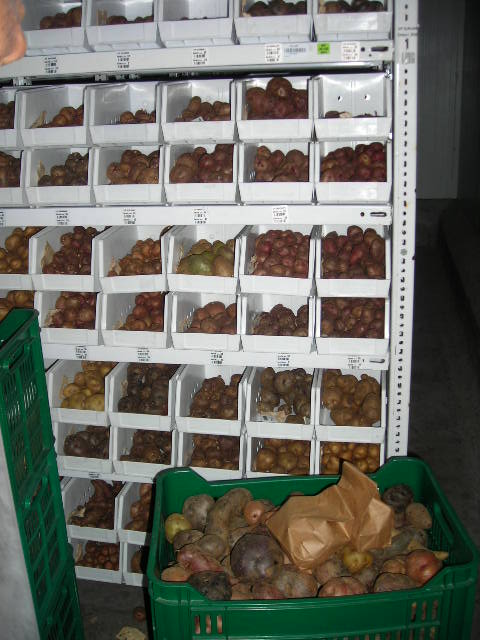
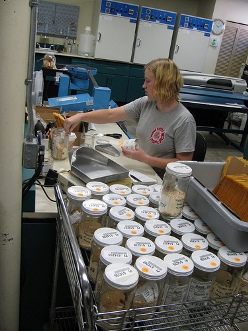
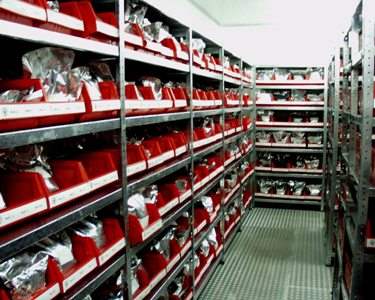
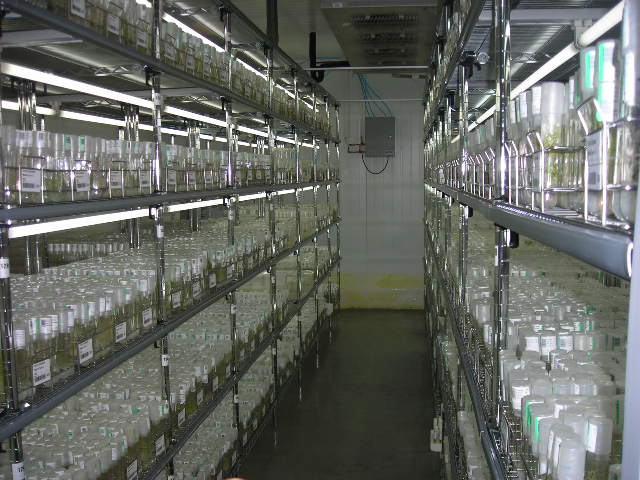
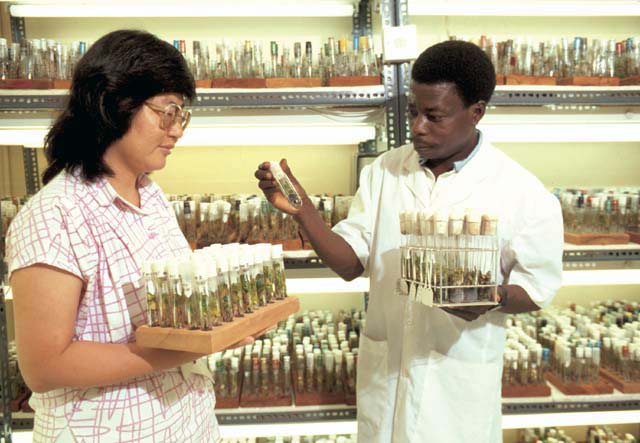

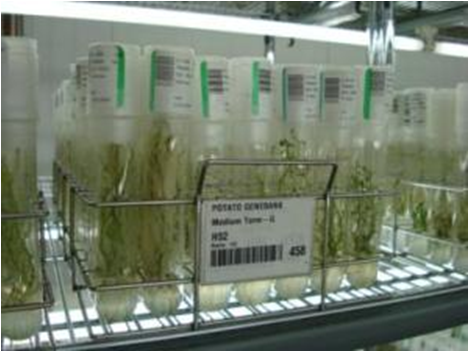
.JPG)
.JPG)
.JPG)